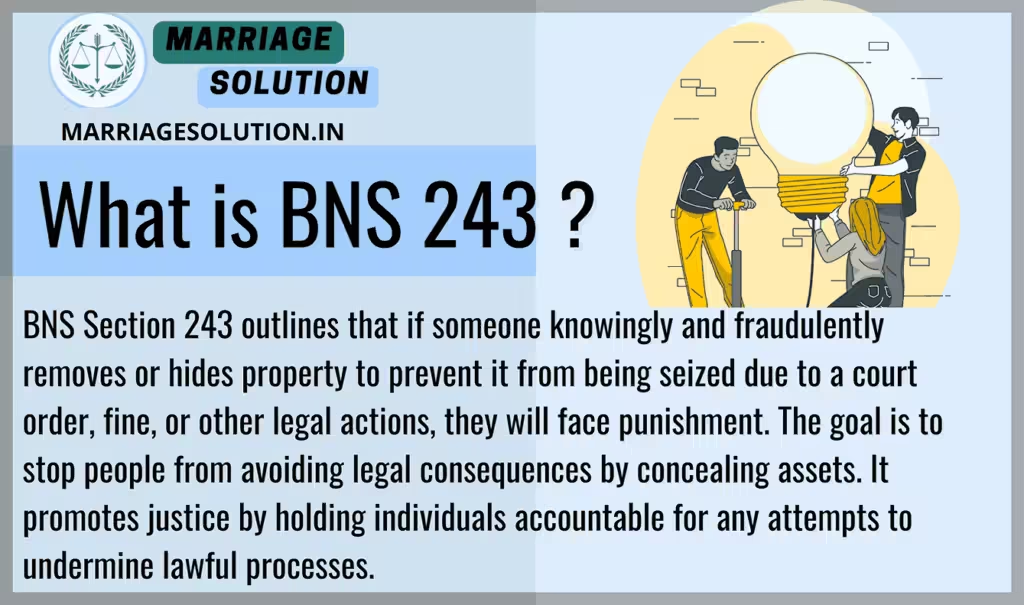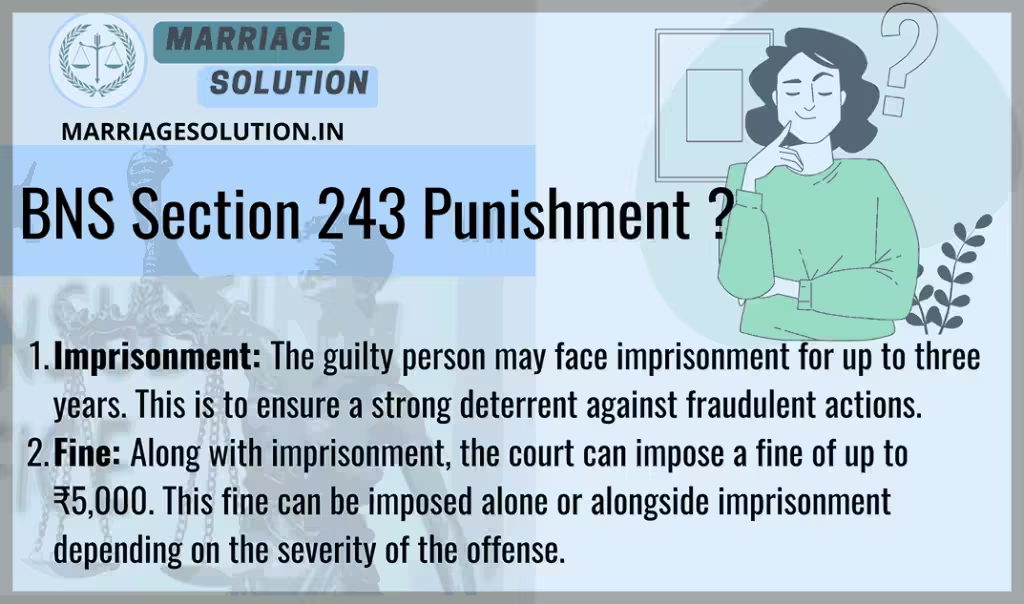Introduction of 243 BNS
Bharatiya Nyaya Sanhita (BNS) Section 243 makes it a crime to fraudulently hide, remove, or transfer property in order to stop it from being seized as forfeited or in execution of a court decree or fine. The law ensures that offenders and debtors cannot escape legal obligations through dishonest means. It protects the authority of court orders and promotes justice by punishing fraudulent attempts to conceal assets.
The Bharatiya Nyaya Sanhita (BNS) Section 243 replaces the old Indian Penal Code (IPC) Section 206.
What is BNS Section 243 ?
BNS Section 243 outlines that if someone knowingly and fraudulently removes or hides property to prevent it from being seized due to a court order, fine, or other legal actions, they will face punishment. The goal is to stop people from avoiding legal consequences by concealing assets. It promotes justice by holding individuals accountable for any attempts to undermine lawful processes.

Under Section 243 of the bns act 2023
“Whoever fraudulently removes, conceals, or transfers any property in order to prevent it from being lawfully seized, either as forfeited or in execution of a decree, sentence, or fine, shall be punished with imprisonment for a term which may extend to three years, or with fine which may extend to five thousand rupees, or with both.”
1. Meaning of “Fraudulent Removal or Concealment of Property”
- This section applies when a person knowingly hides, removes, or transfers property to stop it from being seized by legal authority.
- Property may be seized in execution of a fine, forfeiture, or decree passed by a court.
- Even anticipatory acts—hiding assets before seizure actually begins—are covered.
- The offence requires fraudulent intent; accidental loss or transfer without such intent is not punishable.
2. Who is Covered?
This section applies to:
- Individuals facing fines or court orders who try to protect their assets dishonestly.
- Debtors or convicts whose property is at risk of seizure.
- Anyone with knowledge that their property will be legally seized but who takes fraudulent steps to prevent it.
3. Nature of the Offence
- Non-Cognizable → Police cannot arrest without magistrate approval.
- Bailable → The accused has the right to seek bail.
- Non-Compoundable → Cannot be settled privately; must go through legal trial.
- Triable by Any Magistrate → Any Magistrate can hear and decide the case.
4. Examples of BNS Section 243
- Example 1 – Land Transfer
A man whose land is about to be seized to satisfy a fine quickly transfers it to his brother to avoid court attachment. → Punishable under Section 243. - Example 2 – Hiding Jewellery
A woman, knowing her jewellery will be seized in execution of a decree, hides it with a friend. → Covered by this section. - Example 3 – Not an Offence
If property is sold for genuine reasons without any intent to prevent seizure, the act is not punishable.
5. Punishment under BNS Section 243
- Imprisonment → Up to 3 years.
- Fine → Up to ₹5,000.
- Both → Court may impose both depending on severity.
6. Importance of BNS Section 243
- Prevents dishonest evasion of lawful seizure.
- Ensures enforcement of court orders like fines and decrees.
- Protects creditors and victims by stopping fraudulent concealment.
- Maintains trust in judicial enforcement and accountability of offenders.
Section 243 BNS Overview
BNS Section 243 defines the act of fraudulently removing, hiding, or transferring property to prevent it from being seized by the court. It applies when someone knows their property is going to be taken under legal authority (either as a fine or court order) and they take steps to avoid it. The punishment for this offense includes imprisonment for up to three years, a fine of ₹5,000, or both.
10 Key Points of BNS Section 243
- Fraudulent Action is Required:
- The person must intentionally take action to remove, conceal, or transfer their property. This fraudulent behavior is a key element of the offense. It applies to people who knowingly try to hide their assets to prevent them from being seized by authorities.
- Prevention of Legal Seizure:
- The main objective of this section is to stop individuals from obstructing the legal process. For example, if a person knows that their property is going to be seized due to a court order or fine, and they hide the property to avoid losing it, they violate BNS 243.
- Applies to Both Present and Future Seizures:
- This law applies whether the court has already ordered the seizure or if the person knows that such an order is likely to happen in the future. Even if the property hasn’t been seized yet, any attempt to avoid future legal action falls under this offense.
- Includes Any Property or Interest:
- This section covers all kinds of property, whether it is physical, financial, or any other valuable asset. The individual’s interest in the property, even if partially owned, cannot be hidden or transferred to avoid seizure.
- Intention is Key:
- To be guilty under BNS 243, the person must have intended to prevent the property from being taken by the court. If the action was accidental or without fraudulent intent, it may not fall under this section.
- Punishment for the Offense:
- If someone is found guilty of violating BNS Section 243, they can face imprisonment for up to three years. This is to ensure that there is a strong deterrent against such fraudulent activities.
- Fine Along with Imprisonment:
- In addition to imprisonment, the court can impose a fine of up to ₹5,000. This fine can be applied alone or in combination with imprisonment, depending on the severity of the case.
- Bailable Offense:
- Offenses under BNS 243 are bailable, which means that the accused person can apply for bail and may be released from custody while awaiting trial.
- Non-Cognizable Offense:
- BNS 2243 is classified as a non-cognizable offense, meaning that the police cannot arrest the accused without a warrant. The case has to be initiated through a complaint in court.
- Triable by Any Magistrate:
- Cases under BNS Section 243 can be tried by any Magistrate. This gives flexibility in handling the case and allows it to be processed at various levels of the judicial system.
Examples of BNS Section 243
- Example 1:
- Ramesh owns a piece of land that is about to be seized by the court to satisfy a fine imposed on him. Knowing this, Ramesh secretly transfers the ownership of the land to his brother to avoid losing it. This is a violation of BNS Section 243 because Ramesh fraudulently transferred the property to prevent the court from seizing it.
- Example 2:
- Sita is aware that her jewelry is going to be taken by the court as part of a civil case order against her. To prevent this, she hides the jewelry with a friend, hoping the court won’t be able to find it. By doing this, Sita commits an offense under BNS Section 243 as she fraudulently concealed her property to avoid seizure.
BNS 243 Punishment
- Imprisonment:
- The guilty person may face imprisonment for up to three years. This is to ensure a strong deterrent against fraudulent actions.
- Fine:
- Along with imprisonment, the court can impose a fine of up to ₹5,000. This fine can be imposed alone or alongside imprisonment depending on the severity of the offense.

BNS 243 bailable or not ?
- Bailable: Yes, offenses under BNS Section 2243 are bailable, meaning the accused can seek bail from the court.
Comparison Table — BNS Section 243 vs IPC Section 206
| Section | What it Means | Punishment | Bailable? | Cognizable? | Trial By |
|---|---|---|---|---|---|
| BNS Section 243 | Penalises fraudulent removal, concealment or transfer of property to prevent it being lawfully seized as forfeited or in execution of a decree, sentence or fine. | Imprisonment up to 3 years, or fine up to ₹5,000, or both. | Bailable | Non-cognizable | Any Magistrate |
| IPC Section 206 (Old) | Punished anyone who fraudulently removes, conceals or transfers property to prevent its lawful seizure under a decree, forfeiture, or execution. | Imprisonment up to 3 years, or fine, or both (same maximum penalty). | Bailable | Non-cognizable | Magistrate |
| Key Difference: BNS 243 retains the substance of IPC 206 but updates the statutory framing and explicitly specifies modern penalty limits (fine up to ₹5,000). BNS wording focuses on clearer modern alignment while the core offence, intent and procedure remain the same. | |||||
BNS Section 243 FAQs
What is BNS Section 243?
BNS Section 243 deals with preventing fraudulent removal, concealment, or transfer of property to avoid seizure by court orders or legal actions.
What happens if someone tries to hide their property to avoid a court fine?
They can be punished with imprisonment for up to 3 years or fined up to ₹5,000, or both.
Does BNS Section 243 only apply to physical property?
No, it applies to all types of property, including land, money, or other assets.
What if the court hasn’t yet passed the order but someone still hides their assets?
Even if the court has not yet officially passed the order but the person knows it is likely to happen, hiding or transferring property is still a violation.
Who handles cases under BNS Section 243?
Any Magistrate can try cases under this section, and it is classified as non-cognizable.
Conclusion
BNS Section 243 reinforces the principle that no one can evade justice by hiding assets. By punishing fraudulent concealment or transfer of property meant for seizure, the law protects the effectiveness of judicial decrees and the rights of creditors or victims.
With penalties of up to three years’ imprisonment, a fine of ₹5,000, or both, the section provides a strong deterrent against such dishonest acts. It balances fairness by making the offence bailable and non-cognizable, ensuring due process while still holding offenders accountable.
In short, Section 243 safeguards the credibility of court orders and ensures that justice is not defeated by fraudulent concealment of property.
Need Legal Support?
If you are dealing with court cases, marriage problems, or any other legal issue, our team at Marriage Solution – Lawyer Help is here for you. Simply fill out our quick online enquiry form, and we’ll connect you with the right legal expert to support your needs.
Finished with BNS 243 ? Continue exploring the next provisions of the Bharatiya Nyaya Sanhita (BNS), 2023. Each section includes explanations, examples, and plain-language breakdowns for easy understanding.
- BNS 244 : Fraudulent claim to property to prevent its seizure as forfeited or in execution.
- https://marriagesolution.in/bns_section/bns-244/
- 245 BNS : Fraudulently suffering decree for sum not due.
- https://marriagesolution.in/bns_section/245-bns/
- 246 BNS : Dishonestly making false claim in Court.
- https://marriagesolution.in/bns_section/246-bns/
- 247 BNS : Fraudulently obtaining decree for sum not due.
- https://marriagesolution.in/bns_section/247-bns/
- BNS 248 : False charge of offence made with intent to injure.
- https://marriagesolution.in/bns_section/bns-248/
Full IPC Section List: https://marriagesolution.in/ipc-section-list
All Indian Law & Blogs: https://marriagesolution.in/indian-law/
Full BNSS Section List: https://marriagesolution.in/bnss_section-list
